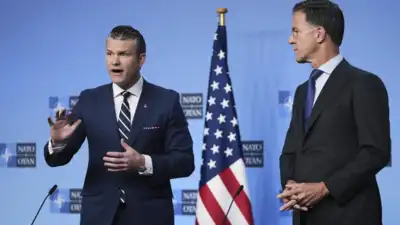
US defense secretary Pete Hegseth, left, and Nato Secretary General Mark Rutte deliver statements ahead of a meeting of Nato defense ministers at Nato headquarters in Brussels. (Picture credit: AP)
Nato allies are nearing consensus on a new defence spending target of five per cent of GDP, US defence secretary Pete Hegseth said Thursday, in a move aimed at satisfying US President Donald Trump’s longstanding demand for increased contributions from member states.Speaking after a meeting with Nato defence ministers in Brussels, Hegseth said, “Countries in there are well exceeding two per cent and we think very close, almost near consensus, on a five per cent commitment for Nato in The Hague later this month.” He added that while a few countries were not yet on board, “We’ll get them there.”The proposed benchmark, expected to be formally discussed during the June 24-25 summit in the Netherlands, includes 3.5 per cent of GDP on core defence spending and 1.5 per cent on infrastructure such as roads and ports needed to support military deployments, as per news agency AFP.Nato Secretary-General Mark Rutte confirmed ministers agreed on “capability targets” to strengthen military readiness. These targets involve priority acquisitions like long-range missiles, drones, and air defence systems, as well as logistics tools to enhance rapid deployment. “All these investments have to be financed,” Rutte said, as quoted by news agency AP.The spending deal likely appears to be a compromise designed to let Trump claim success on his five per cent demand while allowing some flexibility for reluctant allies.
Among the most hesitant is Spain, which is only expected to meet the current two per cent benchmark this year. Several countries are reportedly negotiating for a longer timeline and looser annual increase requirements.The urgency is driven in part by the growing Russian threat. “When you consider the threats that we face, the urgency in the world, it’s critical. We don’t need more flags. We need more fighting formations,” Hegseth told reporters.Germany’s defence minister Boris Pistorius acknowledged that the new military readiness targets would require Berlin to add “around 50,000 to 60,000” troops, while Dutch defence minister Ruben Brekelmans said their nation would need to raise defence spending to at least 3.5 per cent of GDP, requiring an additional €16–19 billion.Though the US supports the proposed agreement, Washington is demanding that all member nations present a “credible path” to achieving the goal.
Nato planners are operating on a 5–10 year horizon to meet these benchmarks, amid fears that Russia’s capabilities could surge if the Ukraine war ends.Meanwhile, as the spending deal progresses, debate continues over Ukraine’s role at the upcoming summit. While Kyiv’s allies are pushing for President Volodymyr Zelensky to attend as a signal of unity, Nato has so far only confirmed that Ukraine will be represented.However, Hegseth skipped a Ukraine-related meeting this week, hinting at America’s shifting engagement under Trump.

 1 day ago
48
1 day ago
48




























 English (US)
English (US)